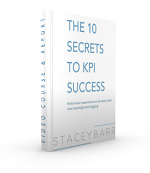The Single Best Thing You Must Do To Find Useful KPIs
by Stacey Barr |Weasel words are words that have no specific and obvious and singular meaning. They bring no clear images to mind of what is meant. Words like: effective, sustainable, harnessed, connectedness and leveraged. Weasel words have a stupifying effect on people’s understanding of goals that are written with them, as well as rendering those goals immeasurable.

If your goals or objectives (the things you’re trying to measure) contain words like these, you are either struggling to find meaningful measures, or you don’t realise that the measures you have aren’t meaningful. Here’s but a sample:
…accelerate, accessibility, accountability, active, adaptive, advocating, affective, alignment, balanced, barriers, basic, benchmarked, benefits, best practice, brand (image), capacity, centrality, challenges, change, client-driven, collaborative, compelling, competence, competitive, connectedness, considered, consultative, continuing, core, delivery, demonstrated, deployable, dis-established, diversity, drive, dynamic, effective, efficient, embedded, empowered, enablers, end-to-end, end-user, evidence-based, focus, foster, empowered, engaged, enhancements, excellence, fit for purpose, flexibility, flourish, forward-looking, fundamental, going forward, gold-plating, governance, ground-breaking, growth, harness, harvested, high-value, holistic, implications, improvements, inclusive, initiation, innovative, input, integration, integrity, interdependent, interface, issues, key, lean, leveraged, livability, mandated, needs, network, opportunities, optimised, outcomes, outputs, oversighting, ownership, pathways, participation, performance, priority-driven, proactive, processes, productivity, products, progression, progressive, quality, reanimate, recognition, re-engerise, reform, reliability, renewal, responsibility, responsive, rich, rigourous, roadmap, robust, significant, solution, special, standards, strategically, streamlined, strengthened, strong, successful, supported, sustainable, synergies, targeted, transformation, translational, transparent, underpinning, uniqueness, utilised, value, value-added, vanilla solutions, vibrant, wellbeing, winning, world-class, zoomify…
Goals written with weasel words sound like the following examples (‘harvested’ from the first few pages of Google search results for the terms ‘strategic plan 2013’ and ‘corporate plan 2013’). I’ve highlighed the words that, before we tried to design measures or KPIs, I would ask my client to explain the meaning of:
- “Embolden our focus on learning and teaching excellence.”
– from a university
- “Develop, implement and evaluate innovative ways of enhancing our value to clients and stakeholders”
– from a native title tribunal
- “Ensure open and transparent processes and consistent approaches to decision-making”
– from the same native title tribunal
- “The Society will leverage existing special events to develop partnerships with participating organisations”
– from a not-for-profit charity
- “We will inspire and empower our community to be active lifelong learners by creating, promoting, advocating and connecting people to diverse and rich learning opportunities.”
– from a council library
- “Drive, at a State and national level, the development of an innovative, flexible and responsive training sector”
– from a government department of training and workforce development
- “Maintain integrity, accountability, transparency and quality in the governance, performance and reporting of our activities.”
– from the same government department of training and workforce development
- “Advocating for evidence-based policy reform”
– from a cancer council
- “To represent and lead the AOD sector at a national level by promoting effective policies, strategies and approaches that address AOD related harm”
– from an alcohol and drugs council
- “A strong, effective and sustainable organization, providing excellence and innovation in custodianship of the community’s resources”
– from a local government organisation
- “To deliver high quality and consistent services.”
– from an aged care organisation
- “Attracting and serving a diverse and inclusive membership worldwide…”
– from a physics society
- “Sustainable development of mining industry”
– from an economic development agency
- “[Provide] inclusive mental health and well-being programs and services that are evidence-based, culturally sensitive and responsive to individuals, communities and service providers.”
– from a mental health care provider
- “Building community capacity and expanding our sphere of influence to achieve better outcomes”
– from a disability support organisation
- “Intensifying customer engagement and ensuring progress works in harmony with heritage values.”
– from a cultural entertainment venue
- “Develop a skilled, engaged and healthy workforce.”
– from a bus company
To measure weasely goals like these, you have to replace the weasel words with words that describe what you would see or detect in some way if your goal was actually achieved. If you can’t replace them (the “our plan is already cast in stone” situation), then you have to at least translate or define them.
Here are three tips for how to de-weasel your goals:
Tip #1: Write down everyone’s answer to the question “what does this mean?” If those answers have more weasel words in them, ask the question again. And again. And again. Until you don’t have any weasel words left.
Tip #2: Explain your goals to a 10-year old until they can rearticulate those goals in their own words. Maybe their words are the best words to use?
Tip #3: List examples of what those weasel words are trying to describe. Detailed and specific examples. Even if you have dozens of them. Which examples best describe the result implied by your weasely goal? Rewrite the goal more closely based on the words from those best examples.
De-weaseling your goals is the single best thing you can do to finde measures that are sensible and useful in achieving those goals!
TAKE ACTION:
Are you brave enough to share a weasely goal or two from your organisation? If you are, post it on the blog and I will respond with tips to help you de-weasel it.
Connect with Stacey
Haven’t found what you’re looking for? Want more information? Fill out the form below and I’ll get in touch with you as soon as possible.
167 Eagle Street,
Brisbane Qld 4000,
Australia
ACN: 129953635
Director: Stacey Barr




